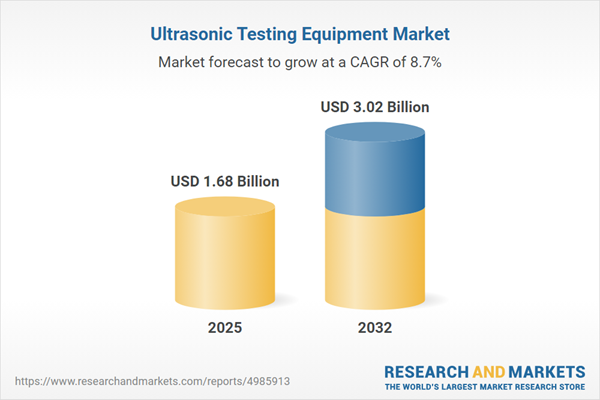Speak directly to the analyst to clarify any post sales queries you may have.
Senior executives in asset-intensive industries are increasingly adopting ultrasonic testing equipment to address evolving compliance, operational, and digitalization challenges. As reliable nondestructive testing solutions become central to asset management, executive teams require clear, actionable insights to support strategic decisions and ensure robust long-term performance.
Market Snapshot: Global Ultrasonic Testing Equipment Market
The global ultrasonic testing equipment market is experiencing consistent growth, driven by ongoing demand from sectors such as aerospace, automotive, oil and gas, construction, and power generation. In 2024, the market reached a value of USD 1.54 billion and is projected to expand to USD 1.68 billion by 2025, with expectations of hitting USD 3.02 billion by 2032. This upward trajectory is fueled by the accelerated integration of digital ultrasonic testing tools, which modernize asset health inspections and align with rigorous nondestructive evaluation standards. The sector is seeing broad adoption across industries aiming to increase productivity and maintain compliance, reflecting a strong executive focus on operational excellence and long-term safety.
Scope & Segmentation: Ultrasonic Testing Equipment Market
- Equipment Types: Bond testers, corrosion mapping systems, flaw detectors, and thickness gauges support comprehensive asset condition assessment and preventive maintenance in diverse settings.
- Techniques: Contact, immersion, phased array, and time of flight diffraction methods deliver adaptable inspection options for a wide range of asset shapes and industry applications.
- Frequencies: High, medium, and low frequency systems enable organizations to customize testing according to material type and operational requirements.
- Materials: Compatibility spans metals, ceramics, plastics, and composites, making solutions relevant across both traditional and advanced infrastructure projects.
- Portability: Laboratory-based and handheld options provide flexibility for centralized or onsite inspections, ensuring effective deployment in varied operational contexts.
- Testing Modes: Manual and automated systems offer versatility for different asset profiles and compliance needs.
- Applications: The technology enables bond verification, corrosion detection, flaw identification, thickness measurement, and weld inspection, strengthening preventive maintenance and operational sustainability.
- End Use Industries: Solutions are tailored for aerospace, defense, oil and gas, automotive, power generation, and construction, meeting unique inspection needs of each sector.
- Regions: Coverage includes the Americas, Europe, Asia-Pacific, and Middle East & Africa, addressing distinct regulatory, infrastructure, and operational requirements.
- Companies: Leading vendors such as Olympus Corporation, Baker Hughes Company, MISTRAS Group, Eddyfi Technologies, Zetec, Sonatest, Magnaflux, Sonotron NDT, NDT Global Holdings, and Vallen Systeme deliver integrated solutions with global technical support.
Key Takeaways for Senior Leaders
- Digital ultrasonic testing equipment streamlines asset health checks and enhances lifecycle management strategies across large enterprise networks.
- Portable and handheld units help reduce inspection timeframes and enable organizations to maintain compliance with regulatory changes affecting widespread asset portfolios.
- Advanced methods like phased array and time of flight diffraction provide fast, accurate diagnostics to uphold stringent quality and safety protocols.
- Flexible testing modalities help executive teams quickly adapt processes to shifting investment goals, operational scenarios, or emerging compliance standards across global regions.
- Recent advances in analytics and reliability technology allow earlier problem identification and intervention, minimizing downtime risks and protecting infrastructure value.
- Adherence to recognized nondestructive testing standards ensures uniform operational practices, supporting oversight needs and consistent program reliability.
Tariff Impact: Supply Chain and Cost Management
Recent adjustments to United States tariffs have prompted suppliers to expand manufacturing capacity globally and optimize regional logistics. In response, leading companies are diversifying sourcing and distribution to limit supply chain vulnerabilities linked to evolving regulatory landscapes. Investment in flexible aftermarket service frameworks remains a vital strategy for maintaining stable asset performance and supporting high service standards.
Methodology & Data Sources
This executive-grade market analysis integrates findings from senior executive interviews, stakeholder consultations, and thorough reviews of technical literature. Structured industry data and verified benchmarks underpin actionable guidance tailored for top-level strategy and procurement decisions.
Why This Ultrasonic Testing Equipment Market Report Matters
- Offers a data-driven framework to align investment and operational strategies with emerging compliance and industry standards across global regions.
- Equips leadership with tools to anticipate and proactively manage shifting supply chain and policy factors that impact asset reliability.
- Delivers timely insights to strengthen competitive positioning and support adjustment to technological and regulatory developments.
Conclusion
This report provides decision-makers with the intelligence essential for deploying ultrasonic testing equipment strategically, ensuring robust asset protection and compliance as industry trends progress.
Additional Product Information:
- Purchase of this report includes 1 year online access with quarterly updates.
- This report can be updated on request. Please contact our Customer Experience team using the Ask a Question widget on our website.
Table of Contents
3. Executive Summary
4. Market Overview
7. Cumulative Impact of Artificial Intelligence 2025
Companies Mentioned
The companies profiled in this Ultrasonic Testing Equipment market report include:- Olympus Corporation
- Baker Hughes Company
- MISTRAS Group, Inc.
- Eddyfi Technologies Inc.
- Zetec, Inc.
- Sonatest Ltd
- Magnaflux, a Division of Illinois Tool Works Inc.
- Sonotron NDT Ltd
- NDT Global Holdings GmbH
- Vallen Systeme GmbH
Table Information
| Report Attribute | Details |
|---|---|
| No. of Pages | 193 |
| Published | October 2025 |
| Forecast Period | 2025 - 2032 |
| Estimated Market Value ( USD | $ 1.68 Billion |
| Forecasted Market Value ( USD | $ 3.02 Billion |
| Compound Annual Growth Rate | 8.7% |
| Regions Covered | Global |
| No. of Companies Mentioned | 11 |









